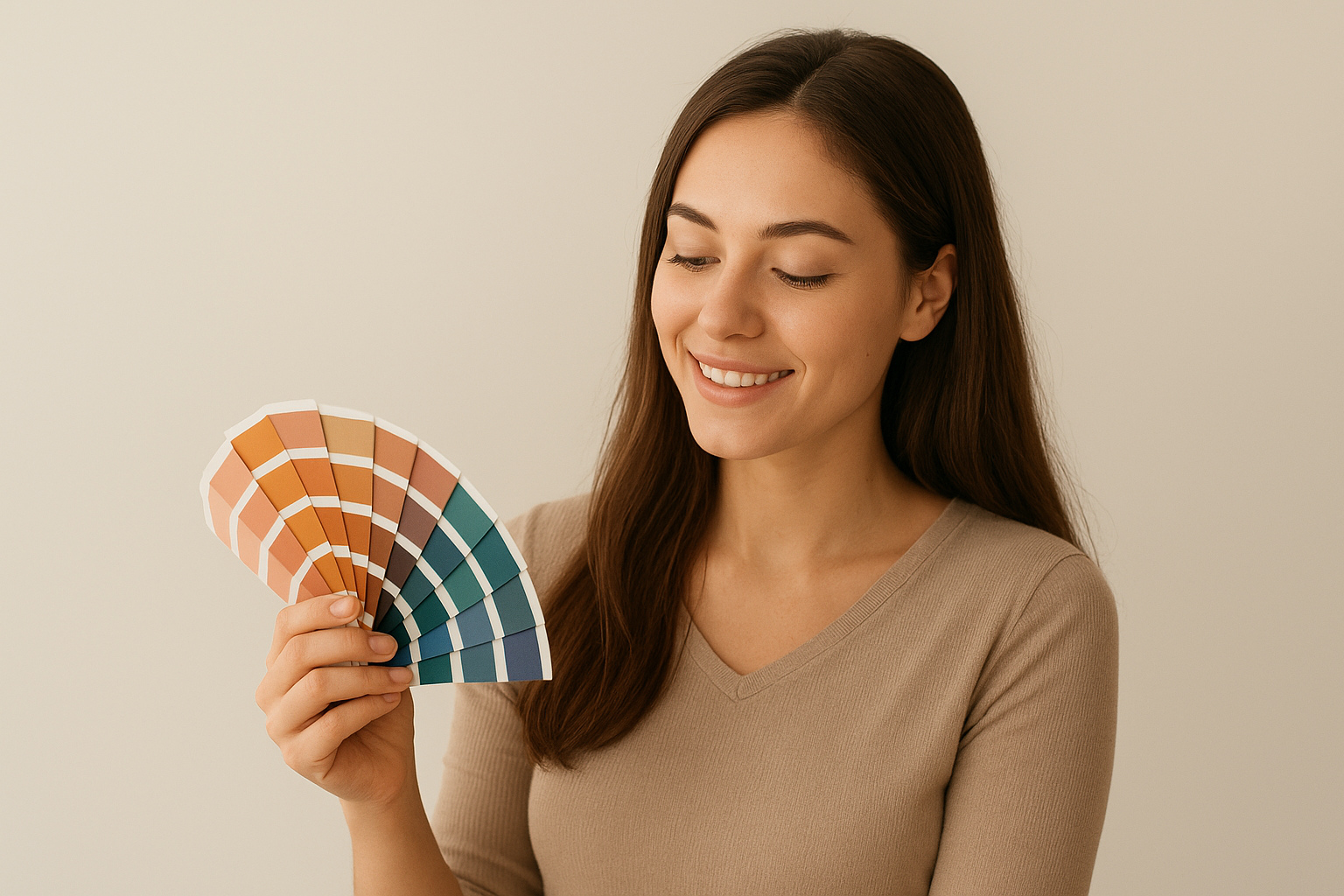Have you ever noticed how some colors seem to brighten your features, while others feel less flattering? This is the power of your personal color palette. Understanding which shades harmonize with your natural features can inspire new ways to dress, apply makeup, and accessorize.
Discovering your color palette is not about following strict rules, it’s about highlighting your natural beauty and making choices that help you look and feel your best. In this guide, we’ll explore how to identify your personal color palette and use it to your advantage.
Why Your Personal Color Palette Matters
Your skin tone, eye color and natural hair color all play a role in determining which shades harmonize with your appearance. The right colors can:
- Brighten your complexion
- Make your eyes stand out
- Reduce the appearance of shadows or dullness
- Help you feel more confident in your style choices
Step 1: Determine Your Skin Undertone
The first step in discovering your personal color palette is understanding your undertone. Your undertone is the subtle hue beneath your skin’s surface and it falls into three categories:
- Warm undertones: Golden, peachy, or yellow.
- Cool undertones: Pink, red, or bluish.
- Neutral undertones: A mix of both warm and cool.
✨ Quick ways to find your undertone:
- Vein test: Look at the veins on your wrist. If they appear green, you likely have warm undertones. If they look blue or purple, you probably have cool undertones. If it’s hard to tell, you might be neutral.
- Jewelry test: Gold jewelry usually flatters warm undertones, while silver suits cool undertones. Neutral undertones often look good in both.
Color specialist Daniel Reed often tells his clients, “Once you know your undertone, shopping becomes simpler: you stop guessing and start glowing.”
Step 2: Identify Your Contrast Level
Your natural contrast comes from the difference in intensity between your skin, hair and eyes. For example:
- High contrast: Dark hair and fair skin.
- Medium contrast: Hair, skin and eyes that are closer in tone.
- Low contrast: Soft, blended tones (like light hair with fair skin).
Your contrast level helps determine whether bold or subtle color combinations will look best on you.
Stylist Ava Martin suggests, “If you’re low-contrast, let your colors whisper; if you’re high-contrast, let them speak up.”
Step 3: Explore the Seasonal Color Analysis
One popular method for identifying your personal palette is seasonal color analysis, which groups people into four main categories:
- Spring: Warm undertones, light and fresh colors like peach, coral and turquoise.
- Summer: Cool undertones, soft and muted shades like lavender, powder blue and rose.
- Autumn: Warm undertones, rich earthy tones like mustard, olive and burnt orange.
- Winter: Cool undertones, bold shades like emerald, black, navy and fuchsia.
✨ Within these categories, there are also subcategories (light, deep, bright, muted) that give you even more precision.
Color analyst Jade Holloway notes that, “Seasonal analysis is less about boxes and more about balance, it’s a starting point to discover harmony, not limitation.”
Step 4: Test with Clothing and Makeup
The best way to confirm your palette is by experimenting.
- Clothing: Hold different colored fabrics near your face in natural light. Notice which colors make your skin glow and which ones highlight imperfections.
- Makeup: Test lipstick shades in warm versus cool tones. See which shades brighten your look instantly.
- Accessories: Try scarves, earrings, or glasses frames in varying shades to see what enhances your features.
Step 5: Build a Wardrobe Around Your Palette
Once you know your palette, you can use it to guide your fashion choices.
- Base colors: Choose neutrals that match your undertone (warm beige, ivory, navy, or charcoal).
- Accent colors: Add pops of color that highlight your natural beauty (coral for warm tones, berry for cool tones).
- Mix and match: Stick to your palette so that everything in your wardrobe works together easily.
Step 6: Apply It to Makeup Choices
You can also use your color palette as inspiration for your makeup choices. These are general ideas to help you explore shades that feel most natural and balanced for you.
- Foundation: Match your undertone for a natural finish.
- Lipstick: Warm undertones shine with corals, brick reds, or warm pinks; cool undertones glow with berry, mauve, or classic red.
- Eyeshadow: Warm undertones pop with golds and bronzes, while cool undertones look radiant with silvers, grays and jewel tones.
Makeup artist Clara Hughes often reminds clients, “The goal isn’t to match your makeup to your outfit, it’s to match it to your essence.”
Step 7: Accessorize with Intention
Accessories can subtly reinforce your palette.
Experiment with jewelry tones that harmonize with your undertone: gold for warm, silver for cool. Play with scarves or eyewear frames in accent colors that make your eyes stand out. Even nail polish can be a fun way to express your palette without overcommitting.
Style mentor Paula James says, “Accessories are your punctuation marks, small details that complete your color story.”
Watch out for These Common Blunders
- Wearing colors that clash with your undertone: (like icy shades on warm undertones).
- Ignoring your contrast level: high contrast individuals need bolder color combinations, while low contrast individuals look better in softer blends.
- Forgetting that your palette is a guide, not a rulebook.
Embracing Your Personal Palette
Discovering your color palette isn’t about restriction, it’s about empowerment. By identifying the shades that naturally complement your features, you can simplify your wardrobe, elevate your makeup routine and always look polished with minimal effort.
The goal is not to eliminate colors you love, but to understand which shades highlight your natural beauty the most. When you know your palette, you’ll feel more confident, put-together and authentically yourself.
